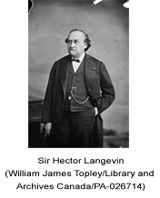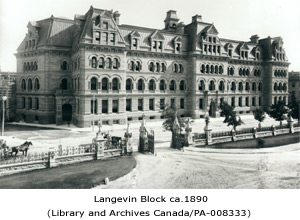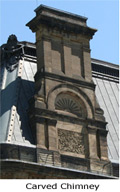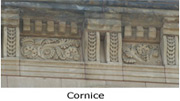Did you Know?
The Langevin Block from Yesterday to Today.
Introduction
 The Langevin Block, a four-storey building in the Renaissance-Second Empire style, was built between the years 1883 and 1889
in response to the growing demand for space by an expanding civil service. In 1891, it was named in honour of
Sir Hector Langevin, a Father of Confederation who served in the government of
Sir John A. Macdonald as Secretary of State,
Superintendent of Indian Affairs, Postmaster General and, during the years in which the building was constructed,
Minister of Public Works. The Langevin Block is one of the finest surviving examples of the work of Thomas Fuller,
and of buildings designed by Public Works in the Second Empire style. Chief Architect for Public Works from 1881 to 1896,
Fuller also designed the original Centre Block and Parliamentary Library. The Langevin Block, a four-storey building in the Renaissance-Second Empire style, was built between the years 1883 and 1889
in response to the growing demand for space by an expanding civil service. In 1891, it was named in honour of
Sir Hector Langevin, a Father of Confederation who served in the government of
Sir John A. Macdonald as Secretary of State,
Superintendent of Indian Affairs, Postmaster General and, during the years in which the building was constructed,
Minister of Public Works. The Langevin Block is one of the finest surviving examples of the work of Thomas Fuller,
and of buildings designed by Public Works in the Second Empire style. Chief Architect for Public Works from 1881 to 1896,
Fuller also designed the original Centre Block and Parliamentary Library.
Origins
Canada was growing quickly and, as a result, the number of parliamentarians and civil servants was increasing. Originally,
it was possible to accommodate all of these officials on Parliament Hill but by the 1880s the buildings were crowded,
even though all available space in basements and attics had been pressed into use. To ease space pressures, departmental
functions were gradually moved out of the Centre Block. Growing government departments continued to occupy the
East and West Blocks but despite an addition to the West Block, more space was still required. were crowded,
even though all available space in basements and attics had been pressed into use. To ease space pressures, departmental
functions were gradually moved out of the Centre Block. Growing government departments continued to occupy the
East and West Blocks but despite an addition to the West Block, more space was still required.
For these reasons, Minister of Public Works Hector Langevin rose in the House during a supply debate in April 1883 to ask
the House to pass a bill authorizing the expenditure of $500,000 for a new departmental building to house the Department
of the Interior and Indian Affairs, the Department of Agriculture, the Patent Office and the Model Rooms:
This vote is for a new building on Wellington street, between
Metcalfe and Elgin streets, with the full depth of the lots. At
present the Departmental buildings are much too small for the
wants of the public service, and we have been obliged to use houses
outside, and still the public offices are much too crowded. The
business is suffering on account of it, due greatly to the increase of
business in the Department of the Interior, Indian Affairs, &c. Under
these circumstances we have decided to secure the lots I have mentioned
in order to erect thereon a building which would suffice, at all events, for
a number of years to come.1
Mr. Paterson, member for Brant, offered a less costly solution for the overcrowding:
I suppose there is something almost so sacred in the hours nine to four,
that it would be impossible to entertain a proposition to alter them, to
perhaps an hour earlier in the morning and an hour later at night, giving
two hours more work to each employee, which, with every employee about the buildings,
would accomplish a vastly greater amount of work than could be managed in
this way, and perhaps accommodation would be found for the requisite number in the
present buildings, saving $600,000,and perhaps enabling us, without the
expenditure of a greater amount of money, to give somewhat larger salaries,
perhaps, to those already employed. It does seem to me the proper way in
the public service – the best for the men and for the country – is to employ as few
hands as possible, and see that they are paid fair salaries for the work which they
do.2
Further expansion on Parliament Hill was considered unfeasible. Not only was there a limited amount of open space on the
Hill, but any additions to the Parliament Buildings complex would have necessitated the use of a compatible Gothic style:
…we found that if extending the Western Block on the square and
then turning toward the north that it would give accommodation, but not
sufficient. We found that it would cost more to make this extension than
to erect a whole new building, for the reason that the architecture of the
extension would have to be in accord with the building as it appears on
the Square. In the building on Wellington street we should be able to have
plenty of light and large airy rooms for the use of the officers who will be
employed there.3
Crown and Town
The Langevin Block was the first building erected by the Department of Public Works outside the boundaries of
Parliament Hill to specifically house federal departments, and was known during the six years of construction as the
“New Departmental Building” or the “Southern Block.” The construction of the Langevin Block was also the first
significant encroachment of the federal government onto privately owned land in Ottawa, instigating problems
between the government (Crown) and the city (town). Because it was desirable to build it as conveniently as
possible to the centre of government, it was decided to take over valuable commercial property on the south
side of Wellington Street, thus removing it from the assessment and tax rolls of the city of Ottawa:
Owing to the business ability of the efficient Minister of Public
Works, this lot in the business centre of the city was obtained for
the moderate price of $86,000 or something less than $3 per foot.
The work of purchasing the property was awarded to Mr. D. O’Connor
of O’Connor & Hogg, who performed his duties so well that the whole
property, which belonged to five or six different persons, was acquired
by him (with the exception of one small lot which was subsequently
expropriated)
without the owners being aware that it was required for
governmental purposes. Had it been otherwise the price would
probably have been much higher, as most people seem to think that the
Government should pay more than private individuals for every thing
they want.4
The effect on city revenues of federal government expropriation of municipal property highlighted the jurisdictional
problems between the two levels of government:
The city itself made direct representation to the government for
compensation, both for the direct loss of tax revenue and for the
increased costs involved in maintaining civic services to government
facilities. While rejecting the idea of a grant in lieu of taxes, the
government did agree to assume financial responsibility for a number
of municipal installations, including the Dufferin and Sapper’s bridges,
Majors Hill Park, and the Chaudière timber slides.5
The issue of compensation for loss of tax revenue was raised in the House of Commons in 1899 by
Napoléon Antoine Belcourt, member for Ottawa:
The revenue which the city would derive if the Government
property paid taxes in the same way that taxes are paid by
ordinary ratepayers would be $250,000. Not only is the
Government property exempt, but civil servants are exempt from
paying income tax which everybody else has to pay. Moreover,
very valuable property, which at one time contributed largely to
the civic revenue, has been expropriated by the Government. The
property on which the Langevin Block now stands yielded a large
amount of taxation, but by the expropriation of that property by the
Government, the city lost the revenue from it.6
The construction of the Langevin Block represented the beginning of a gradual but steady shift in land use along
Wellington Street away from commercial uses to direct government ownership or occupation.
Construction
In September 1883, the contract for the new building was awarded to Alphonse Charlebois of Hull. Although his tender was
$295,000, final costs surpassed $700,000. The completion date was first anticipated for the end of 1885, but it
was extended to May 1886 at the request of the contractor and under the authority of the Minister of Public Works,
and it was not until 1889 that the Langevin Block welcomed its first occupants. The stone required for the exterior
walls caused Mr. Charlebois much frustration. While the basement level was constructed of local stone from Hull,
Thomas Fuller was determined that the contractor use sandstone from Curryville, New Brunswick to complete the building,
and rejected all the local and regional samples that Charlebois submitted. In August 1883, the plans and specifications
for the Langevin Block were made available for public consultation, and one of the exhibits in the Chief Architect’s
office was a fine, dark, red sandstone, similar to the one that Fuller was so intent upon utilizing. After months of
delay, the two men finally agreed upon a warm, olive-coloured sandstone from the Green and Fish quarry in New Brunswick.
It was chosen for its unusual colour, durability and fine grain, which made possible the superb carvings on the building’s
exterior. The disagreement between Fuller and Charlebois concerning the stone led to delays in construction and as a
result, Fuller agreed that the rear wall of the building could be continued with the same local stone as that used for
the basement.

Fire was a great concern in the nineteenth century and an article appearing in the Daily Citizen emphasized the building’s
fireproof features:
Throughout the building every precaution will be taken to render
the building as nearly fire proof as possible. No wood will be used
where it is possible to employ iron, brick, or stone. The whole
building will be of solid stone with brick backing. The floor joisting
and roof will be of iron with brick arches, and concrete filling, and
the flooring of the corridors and entrance halls will be of encaustic
tiles set in cement.7
Over the next few years, the Langevin Block took shape. By May 1, 1889, the second storey was completed and the
Department of the Interior and Indian Affairs moved into its new quarters, followed in 1890 by the Department of
Agriculture and the Post Office. However, not all employees were satisfied with their new workplace, as evidenced
by the opinion of Archibald Lampman, Canadian poet and civil servant, who secured himself a position in the Post Office
Department in 1883:
…Archie became a bit of a troublemaker, the kind of dissatisfied
office worker who considers himself several cuts above his job and
who gripes endlessly about working conditions. “We are all crammed
together like sardines,” he wrote to Maud [his wife] in 1890, when the
department shifted into the new Langevin Block. “There are 13 persons
in my room intended for 8.”8
Architecture
The Langevin Block was designed in a variation of the Second Empire style, popular in Canada in the 1870s and early 1880s.
This style began in France during the reign of Emperor Louis Napoleon III (1852-1870).
 Second Empire style public buildings
are usually several storeys high and of
considerable
length, and their facades are symmetrical
and organized around a series of projecting portions called pavilions. Their distinguishing features are round-headed
windows, pedimented dormers, prominent cornices and carved chimneys. The most singular feature of this style is the steeply
pitched mansard roof which provides additional usable space in the Second Empire style public buildings
are usually several storeys high and of
considerable
length, and their facades are symmetrical
and organized around a series of projecting portions called pavilions. Their distinguishing features are round-headed
windows, pedimented dormers, prominent cornices and carved chimneys. The most singular feature of this style is the steeply
pitched mansard roof which provides additional usable space in the attic. When completed, the Langevin Block was a
fitting
complement to the neighbouring Second Empire style Post Office and row of commercial and institutional structures along
Wellington Street. The principal elevation facing Wellington Street is 280 feet long, that on Elgin Street facing east
measures 110 feet, and the western Metcalfe Street elevation is 99 feet long. The building includes a sub-basement,
basement, three main floors and an attic space. attic. When completed, the Langevin Block was a
fitting
complement to the neighbouring Second Empire style Post Office and row of commercial and institutional structures along
Wellington Street. The principal elevation facing Wellington Street is 280 feet long, that on Elgin Street facing east
measures 110 feet, and the western Metcalfe Street elevation is 99 feet long. The building includes a sub-basement,
basement, three main floors and an attic space.
According to Langevin, the building was to incorporate modern concepts of office design:
…the intention is to make large rooms in order that the clerks, instead
of being separated in small rooms, may be, as far as possible, under
the surveillance of a head officer. We find in all the Departments a
difficulty in this respect. I do not say that officers will try and waste
their time, but the existence of a number of small rooms is not conducive
to the proper administration of affairs. On the contrary, if the rooms
are large as in a bank, the work will be done more quickly, because clerks
can go to each other in respect to matters of work with little trouble,
whereas, if they have to go to separate rooms time is lost, and they are
liable to be delayed by persons in the corridors.9
The most complete descriptions of the early building are to be found in the Public Works Annual Report for 1884:
The ground, first and second floor have central corridors, 10 feet
in width, extending the whole length of the building; on each of
these floors there will be eight large and two small rooms, which
may be sub-divided hereafter by iron partitions. In the attic, the
entire area of the floor, except the staircases, will be available.
There are to be entrances on each of the streets, which will have
fourteen stone steps to lead from the street to the ground floor, eight
feet above the level of sidewalk. The entrance porch will be carried
up to the level of the first floor, boldly treated, richly ornamented
with side pilasters, trusses and carved panels and surmounted by a
bold moulded cornice with pedestals.10
The sweeping central staircase, with its elaborate wrought iron balustrades extending from the first to the fourth floors,
is the focal point of the building’s interior. The stairway lobbies on each floor are framed by arches supported by
columns of polished granite. For reasons of sanitation, the original plans called for the washrooms to be placed in a
building in the rear of the main stairway, separated from the main building by an open court, but during construction
the plans were changed to permit access from the half-landings in the stairwells. The top floor had originally been kept
open in order to house the Model Room of the Patent Office, where model cases were aligned on either side
of the attic corridor. Provisions were made in the original design for four elevators to go from the sub-basement to
the attic. While the offices were originally illuminated by gas, the entire building was wired for electricity in 1898.
While the interior of the Langevin Block has undergone many alterations, Fuller would undoubtedly have no difficulty in
recognizing his exterior design today:
The central projection has a square headed window on either
side of the main entrance, a group of three in each pavilion
and of six in each curtain. On the first floor the windows are
similar in number to the ground floor openings, but they are
semi-circular headed. The jambs have granite shafts with cut
sandstone caps and bases and moulded arches and archivolts.
Under the sill of each is a carved panel. The second floor
windows are in a group, five in the central projection, in one
of four in each pavilion, and, in each of the curtains there are
seven windows grouped in couplets and triplets, all semi-circular
headed and having granite shafts with sandstone caps and bases
in the jambs and moulded arches and archivolts.11
Restoration
The Langevin Block has been home to a number of departments, including the Department of Mines and Technical Surveys and
the Post Office. The Department of the Interior and Indian Affairs, one of the original occupants, occupied the building
until 1965. Throughout the years, various alterations were carried out. Some were intended to accommodate the different
occupants, some to maintain the Langevin Block in good repair, and others to bring it as far as possible up to modern
standards. In 1938, a stone pedestrian passageway was installed near the southeast corner of the Langevin Block,
linking it to the Central Post Office. In 1972, it was decided that a major renovation was in order, and the Ottawa
consulting architectural firm of Miska, Gale and Ling undertook an extensive technical investigation. Their report on
the condition of the Langevin Block indicated that although many of the building’s systems were outdated, it was
possible to carry out the necessary renovations while maintaining its heritage character. The renovation project got
underway in June 1974 and was completed in the fall of 1975. Eric Langley, the Capital Region architect responsible for
the project, faced many challenges while carrying out office renovations:
As the ceiling height was out of proportion to the width of the
office – in some cases ceilings were as high as 20 feet – we decided
to install a false ceiling which would at the same time conceal the
necessary mechanical ducts and surface pipes. This will bring the
typical office into a much more proportional scale. The new false
ceiling has been so designed that it will preserve the character of
the door leading to the corridor but it will not change the appearance of
the office window as seen from inside and outside the building.12
Care was taken to match old hardware where originals were not available. As the box-frame windows were in good condition
they were simply caulked and weatherstripped, and new double-glazing was installed. As well, the original hardwood office
doors were rehung to preserve the character of the hallway. New mechanical and electrical systems and air conditioning were
installed. In 1977, a metal-framed, plexiglass bridge was constructed to provide access to the Blackburn Building.
From 1992 to 1994, Public Works carried out exterior restoration work. The deteriorating copper roof was replaced,
sandstone masonry was repaired and the windows were reconditioned.
Recent History
The renovations carried out in 1974 and 1975 permitted the Langevin Block to welcome new occupants. Staff of the
Privy Council Office and the Prime Minister’s Office who had been located in the East Block moved across Wellington
Street into the newly renovated office and meeting space.
A catastrophe was narrowly averted in the autumn of 1979 when a fire broke out at the Rideau Club, located on
Metcalfe Street across from the Langevin Block.
At the height of the blaze it was feared that the Langevin Block,
across the street, and the United States Embassy immediately west of
the club would also be engulfed. A west wind saved the embassy, but
the roof of the Langevin Block caught fire, sending sheets of flame ten
feet in the air. The fire was brought under control, but while the threat
lasted, a fleet of vans stood ready to remove documents from the Prime
Minister’s Office and the offices of the Privy Council.13
In recognition of the importance of the architecture of the Department of Public Works, the role of Thomas Fuller, and the
movement of employees from Parliament Hill owing to the increase in the size of the civil service, the
Langevin Block was declared a national historic site by the Historic Sites and Monuments Board of Canada in
November 1977.
Notes
1. Official Reports of the Debates of the House of Commons of the Dominion of Canada,
Vol. 14 (April 30,1883), p. 907.
2. Ibid., 909.
3. Ibid., 907.
4. “Departmental Building: How it is proposed that it shall be built” Daily
Citizen, August 25, 1883.
5. Ian Doull. Langevin Block, Ottawa, Ontario (Ottawa: Federal Heritage Buildings
Review Office, 1987), p. 183.
6. Official Reports of the Debates of the House of Commons of the Dominion of
Canada,
Vol. 50 (August 5, 1899), p. 9613.
7. “Departmental Building: How it is proposed that it shall be built” Daily Citizen,
August 25, 1883.
8. Sandra Gwyn. The Private Capital: Ambition and Love in the Age of Macdonald and
Laurier (Toronto: McClelland and Stewart Limited, 1984), p. 441.
9. Official Reports of the Debates of the House of Commons of the Dominion of Canada,
Vol. 14 (April 30,1883), p. 908.
10. Annual Report of the Minister of Public Works for the fiscal year 1883-84. (1884),
p. 37.
11. Ibid., p. 37.
12. Wendy Sailman, “New Life for an Old Building: Langevin Block” The Dispatch,
(Winter 1975), p. 12.
13. Shirley E. Woods, Jr. Ottawa: The Capital of Canada (Toronto: Doubleday Canada,
1980), p. 314.
Bibliography
|





